
Normalizing Volume in VLC A Step-by-Step Guide

Normalizing Volume in VLC: A Step-by-Step Guide
How To Normalize Volume in VLC
How to normalize volume, why should we do it, and what is it after all? – these are the questions when it comes to editing our audio files, as well as the video clips we tend to change the sound of. So, first of all, the volume normalization is pretty much explained as follows: The process when a constant amount of gain is applied to the audio recording, bringing the amplitude to a desirable level, which is “the norm” for the project. If it is a little bit difficult to understand, we have to highlight that when this tool is applied to our volume, the whole recording has the same amount of gain across it, every piece affected the same way. Accordingly, when we normalize volume, the relative dynamics are not changed.
But, why bother at all and why not leave it the way it is? Well, the answer to this is almost the same as on why editing exists in general, right? Things are not perfect! This is the fact that prompts us to make our video clips and audio better, improve it at least on the level which can get us the right amount of viewers and listeners. Everyone have had some pain listening to several podcasts, when the volume was too high or too low, or there were so much background noise that the whole recording was hurting the ears of a person! People will not convert to being loyal subscribers, viewers and listeners if their user experience is not favored. So, it is in our best interest to serve their best interest, with a little bit of editing.
When it comes to normalizing audio, there are two reasons we refer to this tool. First is when we feel we need to get the maximum volume, and the second is when we need to match different volumes.
In the first case, you might have somewhat quite voice recording, and would like to make it better without changing its dynamic range, while making it as loud as possible. And when it comes to matching volumes, it is logical that you need to manipulate your editing this way in case you have a group of audio files, each or some of them are at different volumes, so, understandably, if not necessarily, you would like to make them come closer to the same volume.
So, until we give you the step-by step guide on how to normalize your volume in VLC player, we also need to inform you about audio normalization types. Here, generally, we come across three of them: a so-called peak normalization, helping adjust the recording based on the highest signal level present in the recording; another is called loudness normalization and it adjusts the recording based on perceived loudness. Last but not least, RMS (Root-Mean-Square), changes the value of all the samples, where their average electrical volume overall is a specified level.
Using any of this, making it better to listen to your voice, without people being annoyed and their ears becoming exhausting with what you have to offer, you will be making it enjoyable for them and easy to come back to your content, as they will not be obliged to change the volume on their own audio players. Instead, their experience with you will be calm and effortless, which you are aiming to achieve.
So, not, what about VLC? – this is a very popular media player, favorite for a lot of people all around the world, so you should already be quite familiar with what it is, at least by having streamed videos and movies there. Speaking more of what it represents, it is a free-to-use, robust, and feature-packed software that plays a wide range of audio, image, and video files. It is worth noting that it can also play multimedia files directly from extractable devices or the PC and additionally, the program can stream from popular websites such as Disney+, Hulu, Netflix, and so on.
As if it was not enough, you can do simple video and audio editing in VLC Media Player, which a lot of people are unaware of! For example, you can easily trim and cut videos. So, as it happens, we can also normalize volume in VLC Media Player. It is a very handy feature and it works on Windows as well as on Mac. Sooo… How to do that? Because, actually, it is so simple that you might be surprised you didn’t know about this earlier. To learn how to normalize volume in VLC, follow this simple guideline:
First, of course, as every time working with any software, you need to have VLC Media Player installed on your device. Once you have it installed, open VLC. Go to the Tools and Preferences and there, you will need to check the single box which is next to Normalize volume in Effects. Now, set the level to the one that works best for you. Then, when you are happy with the result, you can Save.
This is not something perfect, because it’s so simple to do and actually what it does is just help adjust the general volume, so it leaves the specifics alone.
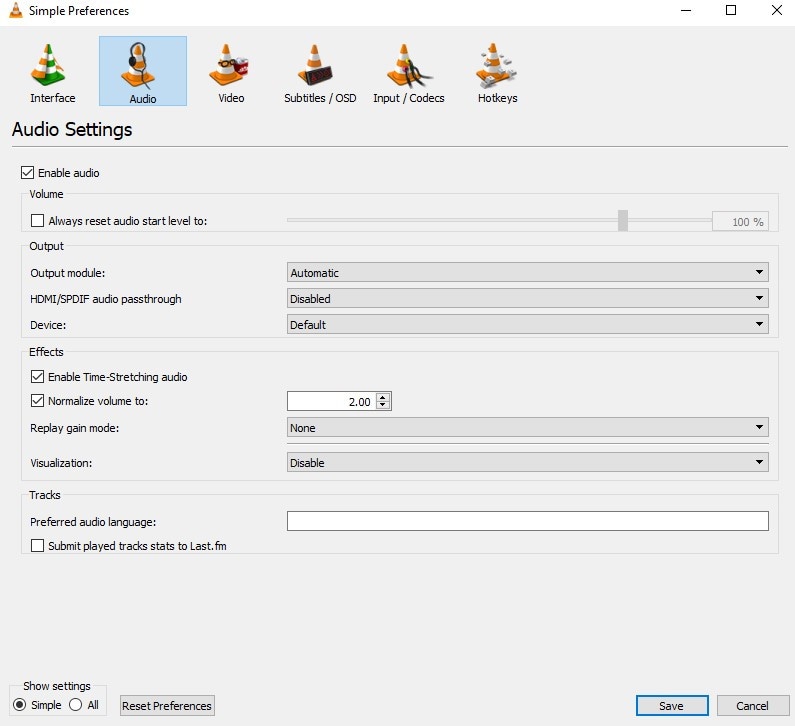
But, it might be the case that you are not so satisfied with the simple editing and want a little more to get from the editing process on VLC. So, you can do more with the Audio Effects menu there. And the steps are as follows:
First, on your VLC player, find Tools and then, in the menu, go to Preferences. The window will open, and there you need to select All in Show settings – actually it is a little bit hard to find because this is in the bottom left corner of the window. From there, you will need to navigate to Audio, and then, a little below, click on Filters and highlight it. The checkbox next to the Dynamic range compressor will probably be unchecked – so, check in it.
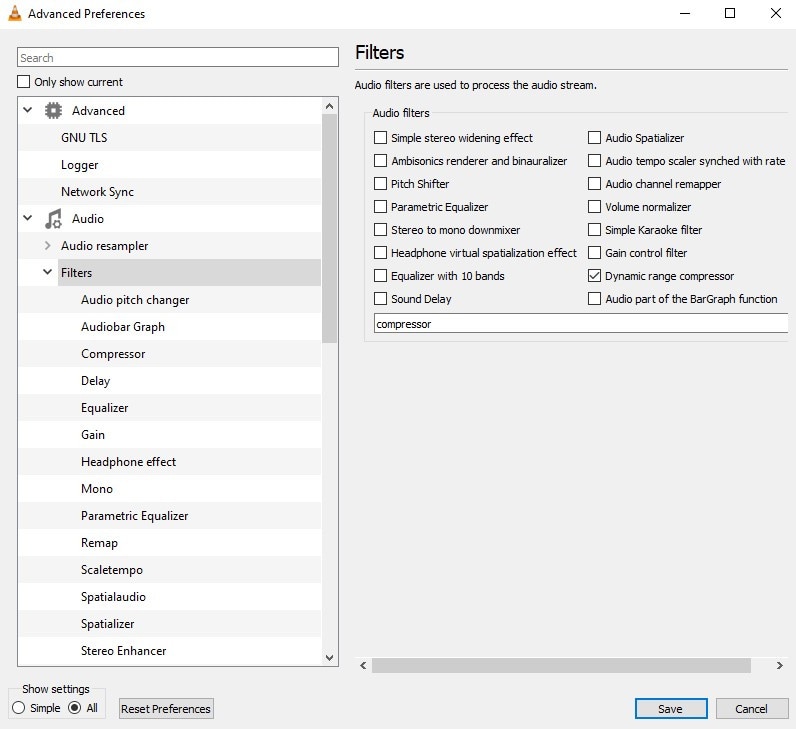
Next, see where Compressor is in the left panel? Select it. And now, you are free to make the changes to the levels as you see fit.
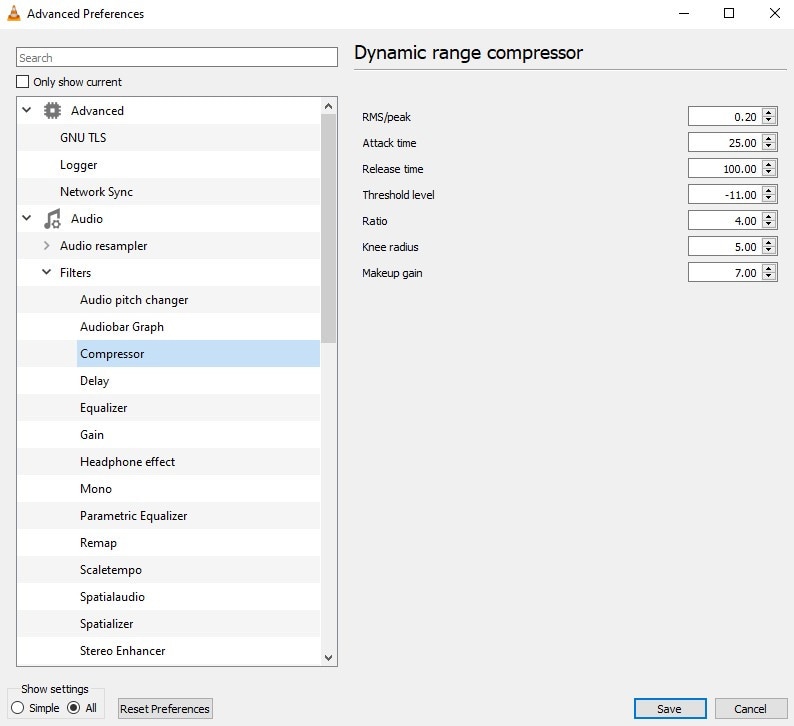
Here, if you are a little bit overwhelmed with the wide range of options to work on, you can just concentrate the most on Makeup gain, Threshold, and Ratio. The first one is by which you adjust in quiet sequences to raise the volume, the second will help you reduce louder sequences to even things out, and ratio is the maximum level of all audio within a movie, let’s say.
Don’t underestimate Attack time and release time, either. They graduate the changes to ramp them up at first, then down again, rather than initiating them immediately. So, if you set them to your liking as well, this will ensure that you have a more fluid transition in and out of the scene and there are less sudden, sometimes scary volume changes.
Therefore, you are now equipped with the most information you will need to normalize volume in VLC Player – so free to give it a go, play around with the different settings and carry out the best result imaginable for you!
How to normalize audio in Wondershare Filmora?
Now, even though we already know how to normalize audio in VLC in the simplest, as well as in the more advanced way, it might be even better if we know some more about normalizing audios in different programs. Something worth discussing is a software called Wondershare Filmora , which carries out the same task wonderfully. Although, unlike VLC Media Player, it is a real video editor , but don’t panic if you have never laid your hand on editing – it is one of the easiest to use ini the word, operating also both on Mac and Windows, and its interface is utterly understandable for beginners right away. And, actually, it is a qhile that Wondershare Filmora X introduced the feature to normalize the audio for the first time. What to say more - you might want to stop now and download the latest version of Filmora because now we are about to learn how to normalize audio from the video there – so, tune in!
Free Download For Win 7 or later(64-bit)
Free Download For macOS 10.14 or later
When it is done installing, open the software. Now, click and drag the video of which the audio you want to normalize. Now you can select the clip you have chosen – if there are multiple, select all of them, then right-click and choose Detach Audio.
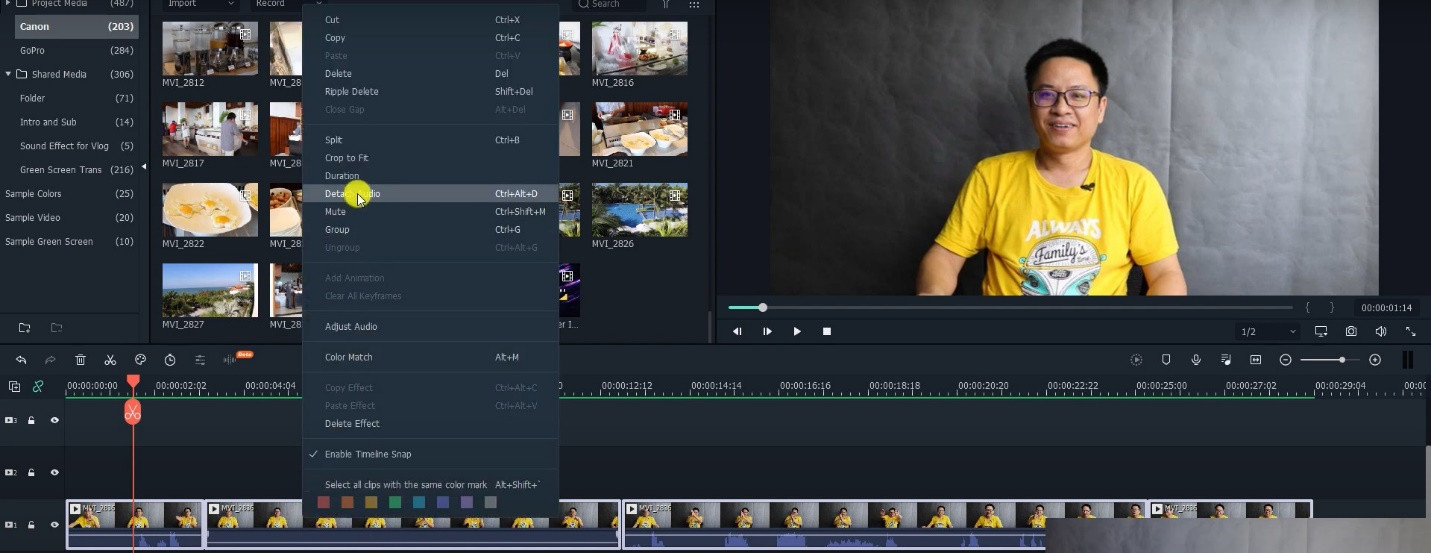
Now if you have this kind of graphic before your eyes, you can be pretty sure without even listening, that the noises are really, really different from each other, which highlights once again how useful audio normalization can be:

Select these files, right-click and choose Adjust Audio. New panel will be opened on left top and there, you will see Audio Normalization – check the box there.
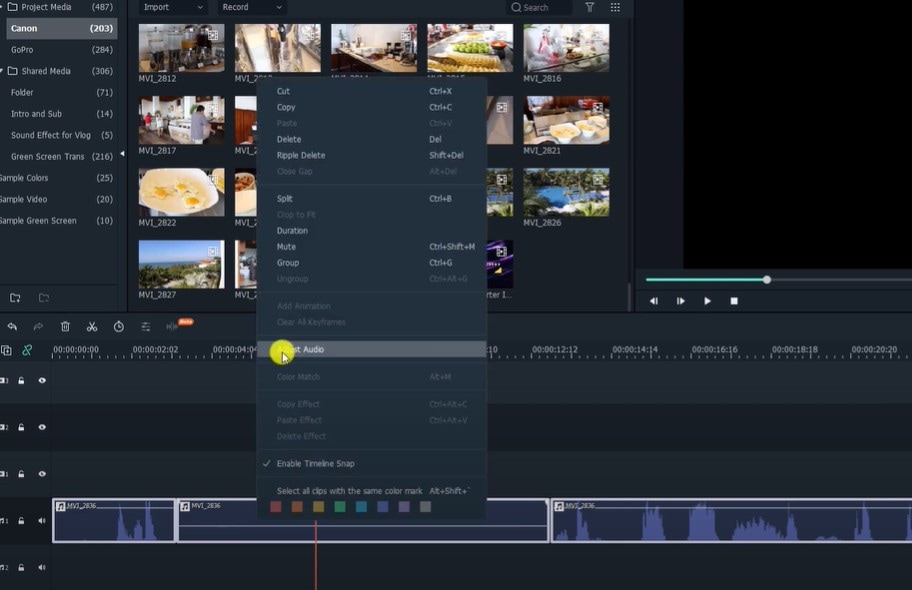
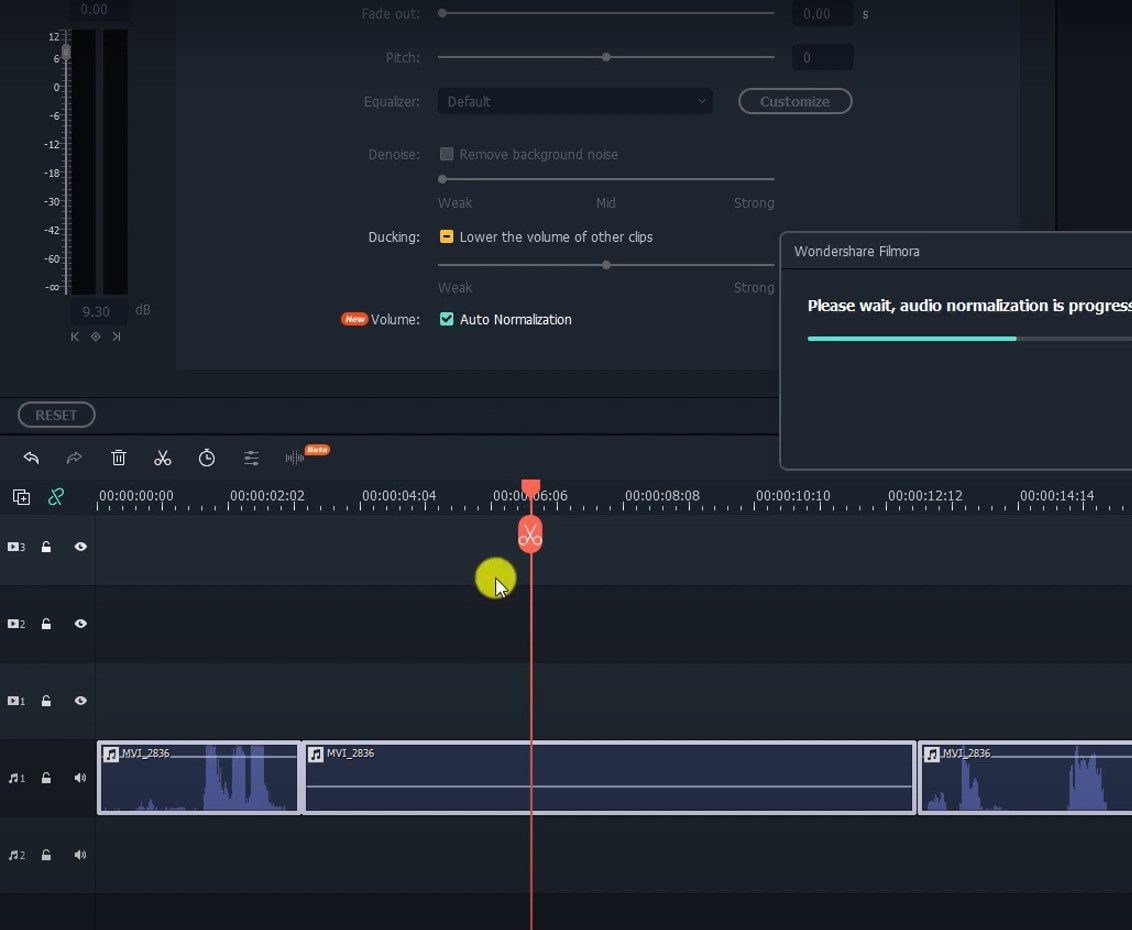
After you have clicked on it, wait until the normalization completes.

Soon, all audio will be normalized, and you will already be able to see on the graphics that the volumes are almost on the same level and when you listen to it, you will make sure that there is no longer apparent difference between how they sound. And from there on, you can save the file you just normalized!
So, in this article, we learned a lot about normalizing volumes, why and how it is done, and, more specifically, how to get this task completed in VLC Media Player as well as in Wondershare Filmora X. you can proceed to putting this new information into a good use and come back to learn more about video and audio editing here!
Free Download For macOS 10.14 or later
When it is done installing, open the software. Now, click and drag the video of which the audio you want to normalize. Now you can select the clip you have chosen – if there are multiple, select all of them, then right-click and choose Detach Audio.

Now if you have this kind of graphic before your eyes, you can be pretty sure without even listening, that the noises are really, really different from each other, which highlights once again how useful audio normalization can be:

Select these files, right-click and choose Adjust Audio. New panel will be opened on left top and there, you will see Audio Normalization – check the box there.


After you have clicked on it, wait until the normalization completes.

Soon, all audio will be normalized, and you will already be able to see on the graphics that the volumes are almost on the same level and when you listen to it, you will make sure that there is no longer apparent difference between how they sound. And from there on, you can save the file you just normalized!
So, in this article, we learned a lot about normalizing volumes, why and how it is done, and, more specifically, how to get this task completed in VLC Media Player as well as in Wondershare Filmora X. you can proceed to putting this new information into a good use and come back to learn more about video and audio editing here!
“Audio Cutting Techniques for MP4 Video Files (2024 Edition)”
While editing an MP4 (MPEG/MPG) clip, we may want to remove audio from the MP4 file completely instead of muting the audio and getting only the video stream as an output.
Sometimes we may want to remove audio from the original file and add a new sound tracker.
To help finish this task, Wondershare Filmora is the right choice. With it, you can either delete all audio tracks completely from MP4 to get the video with no audio in it at all. Or remove an extra audio track and only keep the one you like.
The following article will introduce a simple way of removing audio from video in whatever situation.
MP4 Audio Remover - Wondershare Filmora
Why Choose Wondershare Filmora
- Completely remove the audio from video to keep video-only stream;
- Or mute the audio of the video;
- Easily trim/crop/rotate video files on the timeline;
- Add effect/subtitle/watermark to enrich your video;
- Save and play your video on different devices, burn to DVD or upload online;
- Supported OS: Windows & Mac (above 10.11).
For Win 7 or later (64-bit)
For macOS 10.12 or later
Step 1: Import your MP4 file
Free download the audio track remover- Video Editor, install, and run it. Then the following interface will pop up. Click the “Import” button to add the video file you want to remove audio tracks.
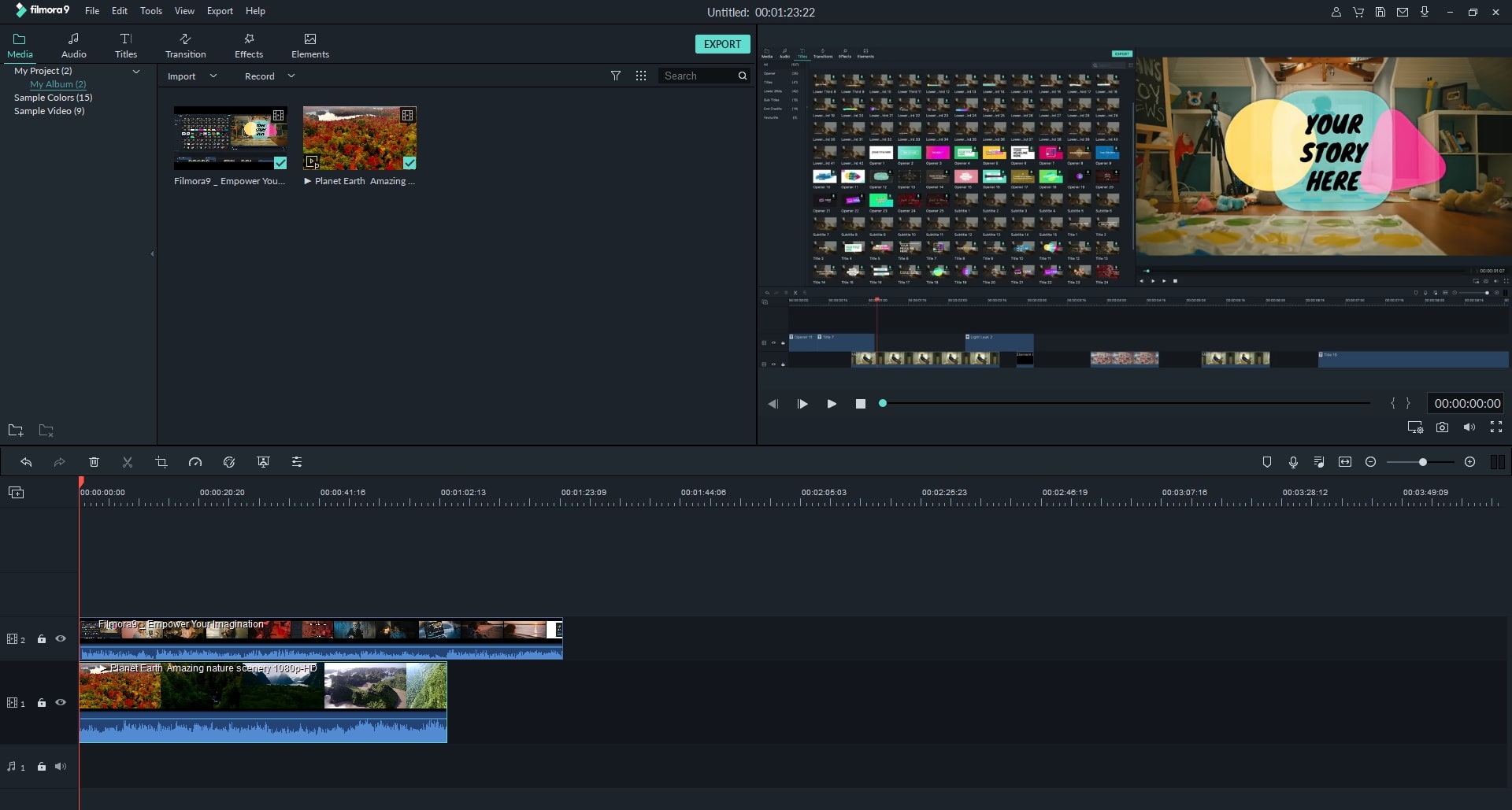
Step 2: Remove audio from the file
Drag-n-drop the mp4 file to the timeline, right-click and choose “Detach Audio” to detach the audio tracks from the original mp4 file. Then the separated audio track will appear in the Audio Timeline. You can right-click the audio and choose “Delete” to remove audio from mp4.
Note: if you want to add the new sound tracker, import the sound recordings you want to the media library and drag them to the audio timeline.
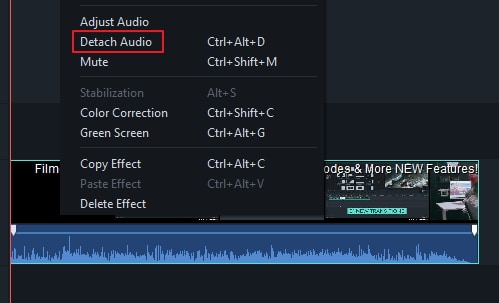
Step 3: Save the edited video
After that, hit “Export” to select the desired output way. You can set the output video format the same as the original one or set the output video format to any other video formats. Then click the “Export” button to export the video. What’s more, you can save the edited file to iPhone, iPad PSP, etc., or directly upload it to YouTube for sharing with friends.
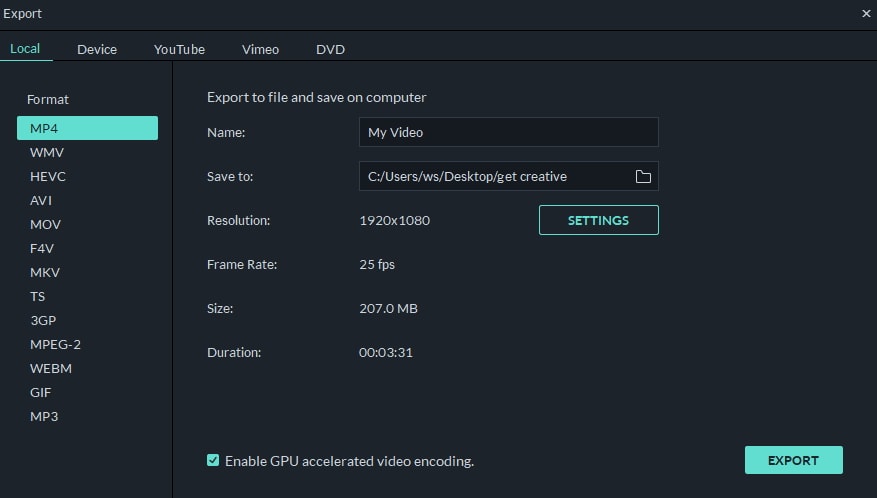
Bonus: Mute a Video with Filmora Video Editor with 1-click
Sometimes, you might wish to mute a video clip for many reasons, then the Filmora Video Editor, as the best MP4 Audio Extractor or Editor will help you do it with 1 simple click.
To reach it, you only need to drag and drop your targeted MP4 video into the timeline, and then, right-click on it and choose “Mute“ option. Then, click “Export” to export and save the edited videos.
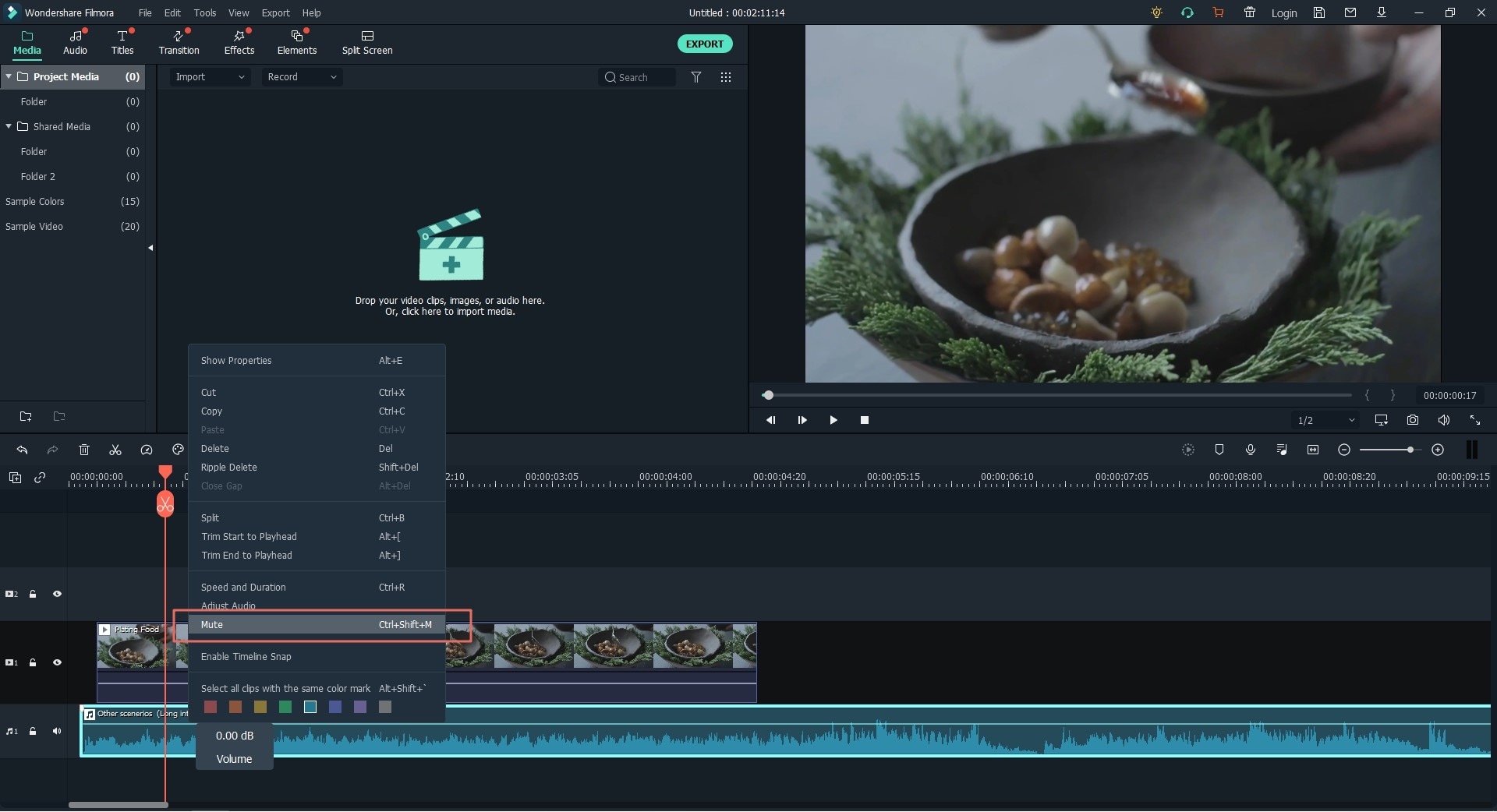
Conclusion
Now, it’s your turn to have a try. Above are the steps to remove audio from video. Leave a comment to let us know if you have any questions.
Versatile Video Editor - Wondershare Filmora
An easy yet powerful editor
Numerous effects to choose from
Detailed tutorials provided by the official channel
For Win 7 or later (64-bit)
For macOS 10.12 or later
Step 1: Import your MP4 file
Free download the audio track remover- Video Editor, install, and run it. Then the following interface will pop up. Click the “Import” button to add the video file you want to remove audio tracks.

Step 2: Remove audio from the file
Drag-n-drop the mp4 file to the timeline, right-click and choose “Detach Audio” to detach the audio tracks from the original mp4 file. Then the separated audio track will appear in the Audio Timeline. You can right-click the audio and choose “Delete” to remove audio from mp4.
Note: if you want to add the new sound tracker, import the sound recordings you want to the media library and drag them to the audio timeline.

Step 3: Save the edited video
After that, hit “Export” to select the desired output way. You can set the output video format the same as the original one or set the output video format to any other video formats. Then click the “Export” button to export the video. What’s more, you can save the edited file to iPhone, iPad PSP, etc., or directly upload it to YouTube for sharing with friends.

Bonus: Mute a Video with Filmora Video Editor with 1-click
Sometimes, you might wish to mute a video clip for many reasons, then the Filmora Video Editor, as the best MP4 Audio Extractor or Editor will help you do it with 1 simple click.
To reach it, you only need to drag and drop your targeted MP4 video into the timeline, and then, right-click on it and choose “Mute“ option. Then, click “Export” to export and save the edited videos.

Conclusion
Now, it’s your turn to have a try. Above are the steps to remove audio from video. Leave a comment to let us know if you have any questions.
Versatile Video Editor - Wondershare Filmora
An easy yet powerful editor
Numerous effects to choose from
Detailed tutorials provided by the official channel
For Win 7 or later (64-bit)
For macOS 10.12 or later
Step 1: Import your MP4 file
Free download the audio track remover- Video Editor, install, and run it. Then the following interface will pop up. Click the “Import” button to add the video file you want to remove audio tracks.

Step 2: Remove audio from the file
Drag-n-drop the mp4 file to the timeline, right-click and choose “Detach Audio” to detach the audio tracks from the original mp4 file. Then the separated audio track will appear in the Audio Timeline. You can right-click the audio and choose “Delete” to remove audio from mp4.
Note: if you want to add the new sound tracker, import the sound recordings you want to the media library and drag them to the audio timeline.

Step 3: Save the edited video
After that, hit “Export” to select the desired output way. You can set the output video format the same as the original one or set the output video format to any other video formats. Then click the “Export” button to export the video. What’s more, you can save the edited file to iPhone, iPad PSP, etc., or directly upload it to YouTube for sharing with friends.

Bonus: Mute a Video with Filmora Video Editor with 1-click
Sometimes, you might wish to mute a video clip for many reasons, then the Filmora Video Editor, as the best MP4 Audio Extractor or Editor will help you do it with 1 simple click.
To reach it, you only need to drag and drop your targeted MP4 video into the timeline, and then, right-click on it and choose “Mute“ option. Then, click “Export” to export and save the edited videos.

Conclusion
Now, it’s your turn to have a try. Above are the steps to remove audio from video. Leave a comment to let us know if you have any questions.
Versatile Video Editor - Wondershare Filmora
An easy yet powerful editor
Numerous effects to choose from
Detailed tutorials provided by the official channel
For Win 7 or later (64-bit)
For macOS 10.12 or later
Step 1: Import your MP4 file
Free download the audio track remover- Video Editor, install, and run it. Then the following interface will pop up. Click the “Import” button to add the video file you want to remove audio tracks.

Step 2: Remove audio from the file
Drag-n-drop the mp4 file to the timeline, right-click and choose “Detach Audio” to detach the audio tracks from the original mp4 file. Then the separated audio track will appear in the Audio Timeline. You can right-click the audio and choose “Delete” to remove audio from mp4.
Note: if you want to add the new sound tracker, import the sound recordings you want to the media library and drag them to the audio timeline.

Step 3: Save the edited video
After that, hit “Export” to select the desired output way. You can set the output video format the same as the original one or set the output video format to any other video formats. Then click the “Export” button to export the video. What’s more, you can save the edited file to iPhone, iPad PSP, etc., or directly upload it to YouTube for sharing with friends.

Bonus: Mute a Video with Filmora Video Editor with 1-click
Sometimes, you might wish to mute a video clip for many reasons, then the Filmora Video Editor, as the best MP4 Audio Extractor or Editor will help you do it with 1 simple click.
To reach it, you only need to drag and drop your targeted MP4 video into the timeline, and then, right-click on it and choose “Mute“ option. Then, click “Export” to export and save the edited videos.

Conclusion
Now, it’s your turn to have a try. Above are the steps to remove audio from video. Leave a comment to let us know if you have any questions.
Versatile Video Editor - Wondershare Filmora
An easy yet powerful editor
Numerous effects to choose from
Detailed tutorials provided by the official channel
“From Sound to Screen: Revolutionary Ways to Auto-Synchronize in the Age of Digital Media Production”
4 Ways to Sync Audio to Video in Filmora and Premiere Pro

Shanoon Cox
Mar 27, 2024• Proven solutions
Watching a video out-of-sync is an extreme turn off. And having a perception that sync audio and video is easy can be misleading. Despite adding sound easily, the actuality lies in its variety of needed operations as well as precision, especially when you have multiple audios and video clips. Moreover, possessing no idea on proper procedure can serve as real headache.
Nonetheless, you are fortunately at the right place as we are going to introduce an advanced technology that can fulfill this motive. Reading this article will prove to be helpful for you as we will enlighten upon syncing audios smoothly on Filmora and Premiere Pro. If you are interested and never want synchronizing issues, have a look upon this post and learn about how to sync audio and video.
- Part 1: How to Automatically Sync Audio to Video with Filmora
- Part 2: How to Sync Audio to Video in Premiere Pro
- Part 3: How to Sync Audio to Video Manually in Premiere Pro
- Part 4: How to Sync Audio to Video with Plug in
Part 1: How to Automatically Sync Audio to Video with Filmora
Auto Audio Sync is one of the best features of Filmora Video Editor . It allows you to adjust the audio tempo to sync with the video. You can slow down or speed up the audio with the button and setting. Auto Audio Sync is the ability to sync video and audio together automatically. Moreover, it is an all-in-one video editor with powerful functionality and a fully stacked feature set. It makes professional video editing easy with an intuitive interface, drag-and-drop editing, and advanced video editing features.
Steps to Use Auto Audio Sync Tool
This tool is best as it gives a perfect result when you try to match your audio files with your video files. For example, you might have a YouTube channel, and you record your audio from a Microphone, your video from a webcam camera, and your screen from your computer. The audio directly from the camera could be a little faint, resulting from the recording being farther from where you are. While the audio from the microphone would give you a high-quality audio.
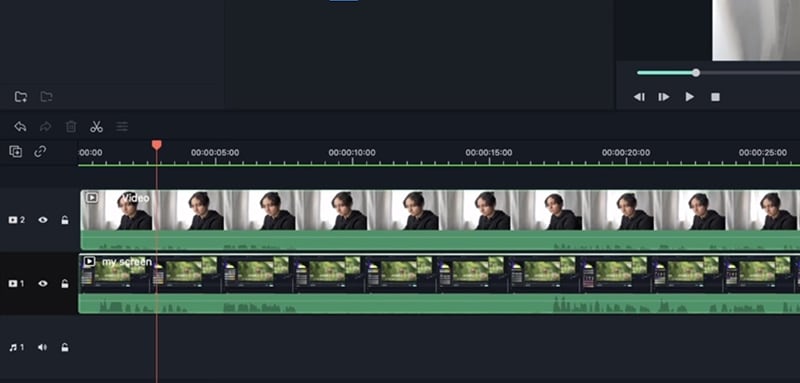
First, detach your audio file from your screen recording as the tool works with an audio file and a video file. Right-click on the audio file and click on detach audio to separate the audio file from the screen recording.
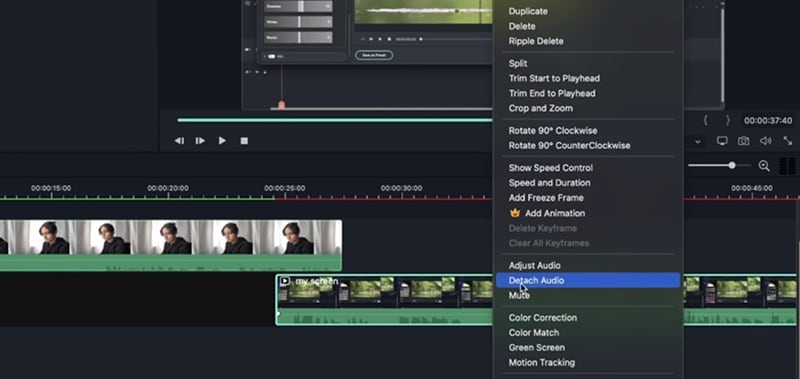
Return the audio file and the screen recording to the normal position, which gives you three layers on the timeline.

Next, select your audio and your video by making sure both footages are related to each other and then right-click and then tap the audio synchronization. This will sync the audio and the video together, and the echo will seize because the footage will perfectly match the audio.
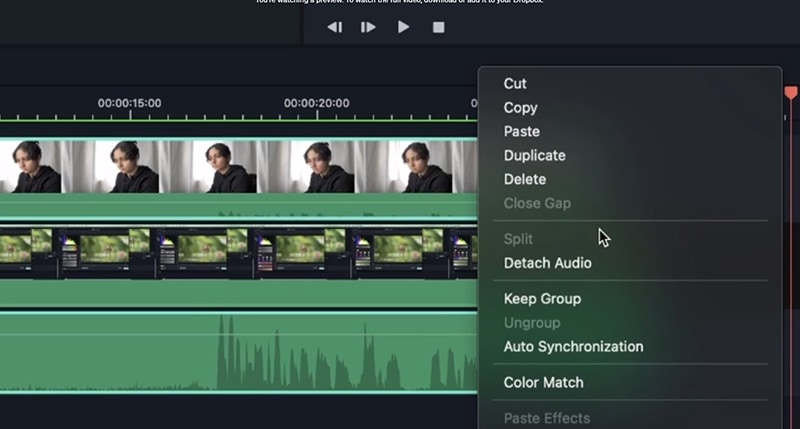
Part 2: How to Sync Audio to Video in Premiere Pro – Merging Audio and Video
The first way that can help you sync audio and video is merging the two files. You can simply get the media from the folders and this allows you to sync a max of 16 audio files to single video.
- To proceed, press Control and Command> key on Windows and Mac respectively. Now, pick out the two files that you want to merge. You will now get the Merge Clips menu having a list of options. Choose Audio option and click OK.
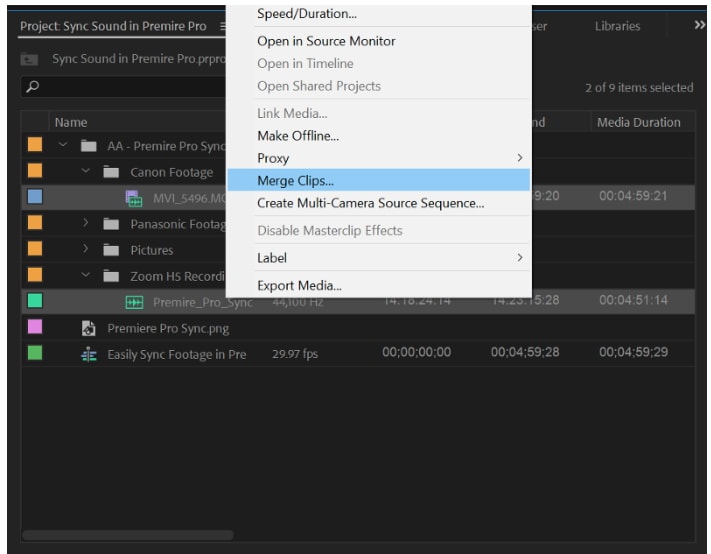
- Premiere Pro will now examine your video’s audio with the help of External audio and find out the similarities. In a couple of minutes, you will receive a new file with the name given to it in the Merge Clips menu.
Part 3: How to Sync Audio to Video Manually in Premiere Pro
- Step 1: Another is the manual way to sync audio to your videos. In order to work with this uncomplicated way of synchronization, get your video clip and the audio file into the timeline. Make sure to stack up the two files loosely (do not group them).
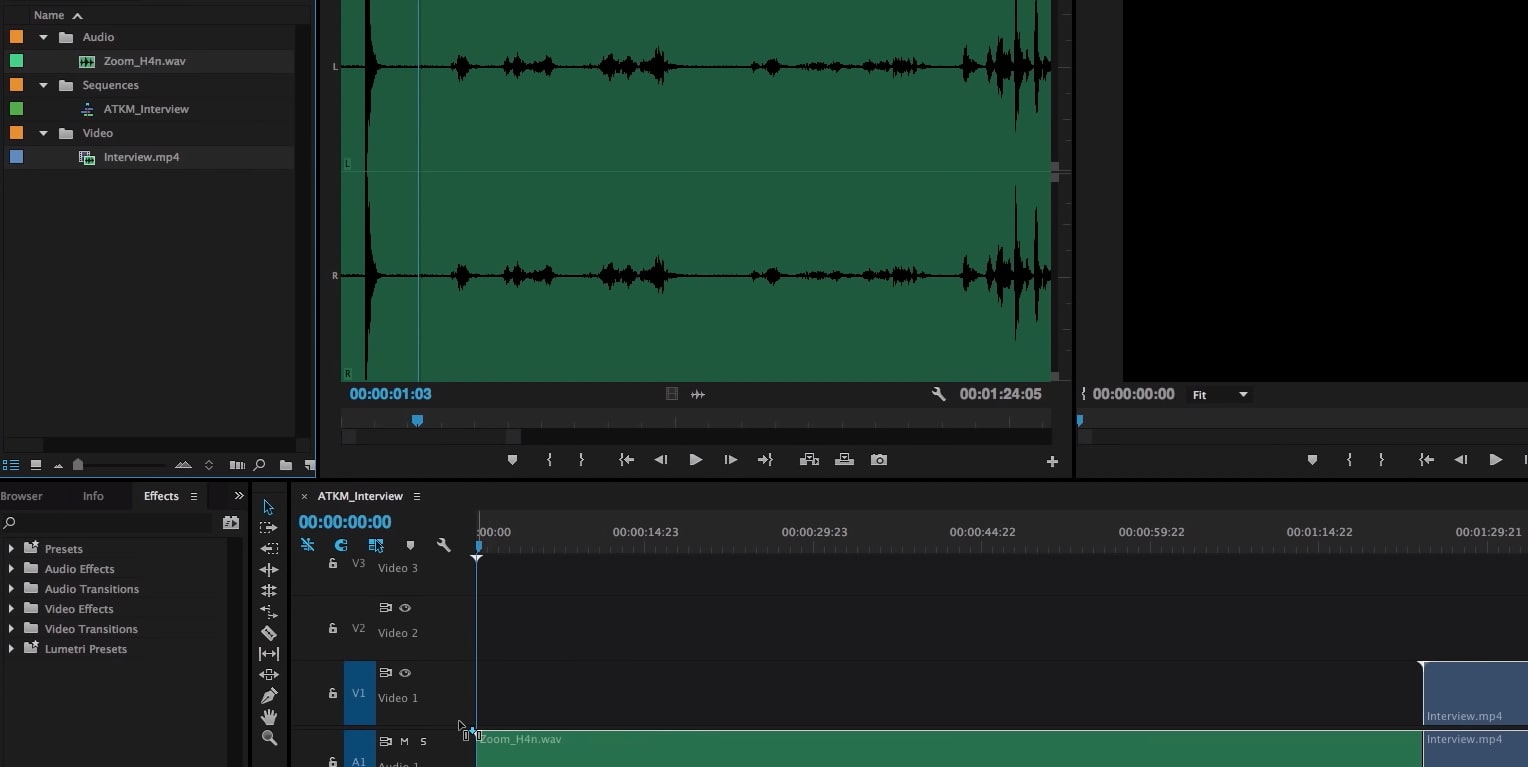
- Step 2: Now, you may have either used a professional slate/clapper or simply done a single clap with your hands to give a clue to start performing. All you need to do is to zoom the video file in the timeline. Look for the spike in waveforms that shows the slate. Where you notice the spike, slide the audio file and make the markers lined up.
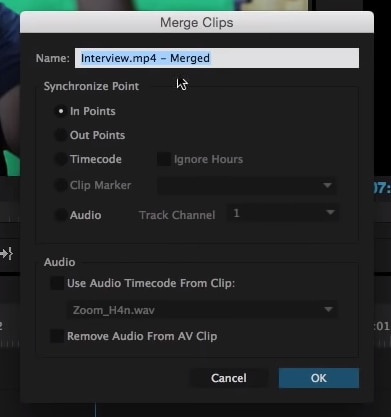
- Step 3: Start playing the clip to see if it works perfectly. Just in case, if a little tweaking is still required, click the audio file and hold down the Shift key while tapping left or right arrow key to adjust the audio file as per requirement.
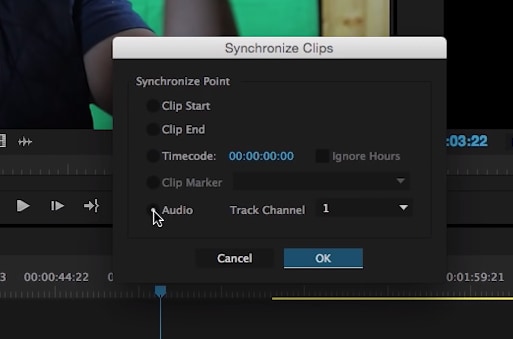
Part 4: How to Sync Audio to Video with Plug in
PluralEyes is the next ideal option to work with. It is a plug-in and comes for $200 from Red Giant. When you have the projects like documentaries which include numerous camera angles, PluralEyes easily handles such stuff and make audio and video synchronization easy for you.
- For this, run PluralEyes and hit on Add Media to import the clip. Alternatively, you can drag and drop the file directly to Premiere Pro. Now, click on Synchronize and let the program do the job.
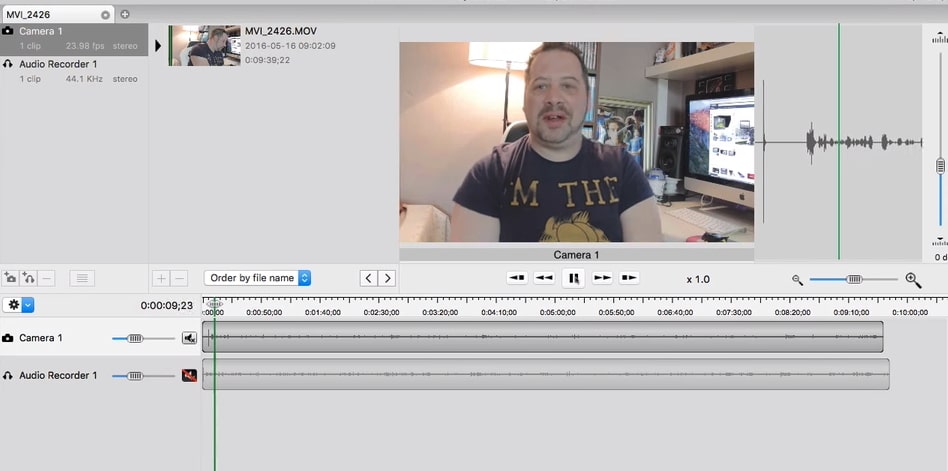
- You will notice the synced clips in green while the files that are not synchronized will show up in red as errors. In case there are files with the red error, you need to get to the Sync drop-down menu and click Try Really Hard.
- When the entire files are synced, hit on Export Timeline and you can then drag the exported project into Premiere Pro.
Bonus Tips: How to Record Audio Properly
Nothing is worse than a bad quality audio file. You must have always wanted to keep a high-quality audio file, correct? More than desire, it is a vital thing to have. Hence, to record your audio appropriately, you must have a quality microphone and an audio recorder that should stand out from others. This dual combination is significant in capturing the sound in an excellent quality and they indeed provide better output than an on-camera microphone.
The audio recorders with a little more price employ XLR cables. On the other hand, some affordable ones make use of the ideal headphone jacks i.e. 1/8” jacks.
You just need to have the right equipment with you when you are looking for the quality output for recording audio files.

Shanoon Cox
Shanoon Cox is a writer and a lover of all things video.
Follow @Shanoon Cox
Shanoon Cox
Mar 27, 2024• Proven solutions
Watching a video out-of-sync is an extreme turn off. And having a perception that sync audio and video is easy can be misleading. Despite adding sound easily, the actuality lies in its variety of needed operations as well as precision, especially when you have multiple audios and video clips. Moreover, possessing no idea on proper procedure can serve as real headache.
Nonetheless, you are fortunately at the right place as we are going to introduce an advanced technology that can fulfill this motive. Reading this article will prove to be helpful for you as we will enlighten upon syncing audios smoothly on Filmora and Premiere Pro. If you are interested and never want synchronizing issues, have a look upon this post and learn about how to sync audio and video.
- Part 1: How to Automatically Sync Audio to Video with Filmora
- Part 2: How to Sync Audio to Video in Premiere Pro
- Part 3: How to Sync Audio to Video Manually in Premiere Pro
- Part 4: How to Sync Audio to Video with Plug in
Part 1: How to Automatically Sync Audio to Video with Filmora
Auto Audio Sync is one of the best features of Filmora Video Editor . It allows you to adjust the audio tempo to sync with the video. You can slow down or speed up the audio with the button and setting. Auto Audio Sync is the ability to sync video and audio together automatically. Moreover, it is an all-in-one video editor with powerful functionality and a fully stacked feature set. It makes professional video editing easy with an intuitive interface, drag-and-drop editing, and advanced video editing features.
Steps to Use Auto Audio Sync Tool
This tool is best as it gives a perfect result when you try to match your audio files with your video files. For example, you might have a YouTube channel, and you record your audio from a Microphone, your video from a webcam camera, and your screen from your computer. The audio directly from the camera could be a little faint, resulting from the recording being farther from where you are. While the audio from the microphone would give you a high-quality audio.

First, detach your audio file from your screen recording as the tool works with an audio file and a video file. Right-click on the audio file and click on detach audio to separate the audio file from the screen recording.

Return the audio file and the screen recording to the normal position, which gives you three layers on the timeline.

Next, select your audio and your video by making sure both footages are related to each other and then right-click and then tap the audio synchronization. This will sync the audio and the video together, and the echo will seize because the footage will perfectly match the audio.

Part 2: How to Sync Audio to Video in Premiere Pro – Merging Audio and Video
The first way that can help you sync audio and video is merging the two files. You can simply get the media from the folders and this allows you to sync a max of 16 audio files to single video.
- To proceed, press Control and Command> key on Windows and Mac respectively. Now, pick out the two files that you want to merge. You will now get the Merge Clips menu having a list of options. Choose Audio option and click OK.

- Premiere Pro will now examine your video’s audio with the help of External audio and find out the similarities. In a couple of minutes, you will receive a new file with the name given to it in the Merge Clips menu.
Part 3: How to Sync Audio to Video Manually in Premiere Pro
- Step 1: Another is the manual way to sync audio to your videos. In order to work with this uncomplicated way of synchronization, get your video clip and the audio file into the timeline. Make sure to stack up the two files loosely (do not group them).

- Step 2: Now, you may have either used a professional slate/clapper or simply done a single clap with your hands to give a clue to start performing. All you need to do is to zoom the video file in the timeline. Look for the spike in waveforms that shows the slate. Where you notice the spike, slide the audio file and make the markers lined up.

- Step 3: Start playing the clip to see if it works perfectly. Just in case, if a little tweaking is still required, click the audio file and hold down the Shift key while tapping left or right arrow key to adjust the audio file as per requirement.

Part 4: How to Sync Audio to Video with Plug in
PluralEyes is the next ideal option to work with. It is a plug-in and comes for $200 from Red Giant. When you have the projects like documentaries which include numerous camera angles, PluralEyes easily handles such stuff and make audio and video synchronization easy for you.
- For this, run PluralEyes and hit on Add Media to import the clip. Alternatively, you can drag and drop the file directly to Premiere Pro. Now, click on Synchronize and let the program do the job.

- You will notice the synced clips in green while the files that are not synchronized will show up in red as errors. In case there are files with the red error, you need to get to the Sync drop-down menu and click Try Really Hard.
- When the entire files are synced, hit on Export Timeline and you can then drag the exported project into Premiere Pro.
Bonus Tips: How to Record Audio Properly
Nothing is worse than a bad quality audio file. You must have always wanted to keep a high-quality audio file, correct? More than desire, it is a vital thing to have. Hence, to record your audio appropriately, you must have a quality microphone and an audio recorder that should stand out from others. This dual combination is significant in capturing the sound in an excellent quality and they indeed provide better output than an on-camera microphone.
The audio recorders with a little more price employ XLR cables. On the other hand, some affordable ones make use of the ideal headphone jacks i.e. 1/8” jacks.
You just need to have the right equipment with you when you are looking for the quality output for recording audio files.

Shanoon Cox
Shanoon Cox is a writer and a lover of all things video.
Follow @Shanoon Cox
Shanoon Cox
Mar 27, 2024• Proven solutions
Watching a video out-of-sync is an extreme turn off. And having a perception that sync audio and video is easy can be misleading. Despite adding sound easily, the actuality lies in its variety of needed operations as well as precision, especially when you have multiple audios and video clips. Moreover, possessing no idea on proper procedure can serve as real headache.
Nonetheless, you are fortunately at the right place as we are going to introduce an advanced technology that can fulfill this motive. Reading this article will prove to be helpful for you as we will enlighten upon syncing audios smoothly on Filmora and Premiere Pro. If you are interested and never want synchronizing issues, have a look upon this post and learn about how to sync audio and video.
- Part 1: How to Automatically Sync Audio to Video with Filmora
- Part 2: How to Sync Audio to Video in Premiere Pro
- Part 3: How to Sync Audio to Video Manually in Premiere Pro
- Part 4: How to Sync Audio to Video with Plug in
Part 1: How to Automatically Sync Audio to Video with Filmora
Auto Audio Sync is one of the best features of Filmora Video Editor . It allows you to adjust the audio tempo to sync with the video. You can slow down or speed up the audio with the button and setting. Auto Audio Sync is the ability to sync video and audio together automatically. Moreover, it is an all-in-one video editor with powerful functionality and a fully stacked feature set. It makes professional video editing easy with an intuitive interface, drag-and-drop editing, and advanced video editing features.
Steps to Use Auto Audio Sync Tool
This tool is best as it gives a perfect result when you try to match your audio files with your video files. For example, you might have a YouTube channel, and you record your audio from a Microphone, your video from a webcam camera, and your screen from your computer. The audio directly from the camera could be a little faint, resulting from the recording being farther from where you are. While the audio from the microphone would give you a high-quality audio.

First, detach your audio file from your screen recording as the tool works with an audio file and a video file. Right-click on the audio file and click on detach audio to separate the audio file from the screen recording.

Return the audio file and the screen recording to the normal position, which gives you three layers on the timeline.

Next, select your audio and your video by making sure both footages are related to each other and then right-click and then tap the audio synchronization. This will sync the audio and the video together, and the echo will seize because the footage will perfectly match the audio.

Part 2: How to Sync Audio to Video in Premiere Pro – Merging Audio and Video
The first way that can help you sync audio and video is merging the two files. You can simply get the media from the folders and this allows you to sync a max of 16 audio files to single video.
- To proceed, press Control and Command> key on Windows and Mac respectively. Now, pick out the two files that you want to merge. You will now get the Merge Clips menu having a list of options. Choose Audio option and click OK.

- Premiere Pro will now examine your video’s audio with the help of External audio and find out the similarities. In a couple of minutes, you will receive a new file with the name given to it in the Merge Clips menu.
Part 3: How to Sync Audio to Video Manually in Premiere Pro
- Step 1: Another is the manual way to sync audio to your videos. In order to work with this uncomplicated way of synchronization, get your video clip and the audio file into the timeline. Make sure to stack up the two files loosely (do not group them).

- Step 2: Now, you may have either used a professional slate/clapper or simply done a single clap with your hands to give a clue to start performing. All you need to do is to zoom the video file in the timeline. Look for the spike in waveforms that shows the slate. Where you notice the spike, slide the audio file and make the markers lined up.

- Step 3: Start playing the clip to see if it works perfectly. Just in case, if a little tweaking is still required, click the audio file and hold down the Shift key while tapping left or right arrow key to adjust the audio file as per requirement.

Part 4: How to Sync Audio to Video with Plug in
PluralEyes is the next ideal option to work with. It is a plug-in and comes for $200 from Red Giant. When you have the projects like documentaries which include numerous camera angles, PluralEyes easily handles such stuff and make audio and video synchronization easy for you.
- For this, run PluralEyes and hit on Add Media to import the clip. Alternatively, you can drag and drop the file directly to Premiere Pro. Now, click on Synchronize and let the program do the job.

- You will notice the synced clips in green while the files that are not synchronized will show up in red as errors. In case there are files with the red error, you need to get to the Sync drop-down menu and click Try Really Hard.
- When the entire files are synced, hit on Export Timeline and you can then drag the exported project into Premiere Pro.
Bonus Tips: How to Record Audio Properly
Nothing is worse than a bad quality audio file. You must have always wanted to keep a high-quality audio file, correct? More than desire, it is a vital thing to have. Hence, to record your audio appropriately, you must have a quality microphone and an audio recorder that should stand out from others. This dual combination is significant in capturing the sound in an excellent quality and they indeed provide better output than an on-camera microphone.
The audio recorders with a little more price employ XLR cables. On the other hand, some affordable ones make use of the ideal headphone jacks i.e. 1/8” jacks.
You just need to have the right equipment with you when you are looking for the quality output for recording audio files.

Shanoon Cox
Shanoon Cox is a writer and a lover of all things video.
Follow @Shanoon Cox
Shanoon Cox
Mar 27, 2024• Proven solutions
Watching a video out-of-sync is an extreme turn off. And having a perception that sync audio and video is easy can be misleading. Despite adding sound easily, the actuality lies in its variety of needed operations as well as precision, especially when you have multiple audios and video clips. Moreover, possessing no idea on proper procedure can serve as real headache.
Nonetheless, you are fortunately at the right place as we are going to introduce an advanced technology that can fulfill this motive. Reading this article will prove to be helpful for you as we will enlighten upon syncing audios smoothly on Filmora and Premiere Pro. If you are interested and never want synchronizing issues, have a look upon this post and learn about how to sync audio and video.
- Part 1: How to Automatically Sync Audio to Video with Filmora
- Part 2: How to Sync Audio to Video in Premiere Pro
- Part 3: How to Sync Audio to Video Manually in Premiere Pro
- Part 4: How to Sync Audio to Video with Plug in
Part 1: How to Automatically Sync Audio to Video with Filmora
Auto Audio Sync is one of the best features of Filmora Video Editor . It allows you to adjust the audio tempo to sync with the video. You can slow down or speed up the audio with the button and setting. Auto Audio Sync is the ability to sync video and audio together automatically. Moreover, it is an all-in-one video editor with powerful functionality and a fully stacked feature set. It makes professional video editing easy with an intuitive interface, drag-and-drop editing, and advanced video editing features.
Steps to Use Auto Audio Sync Tool
This tool is best as it gives a perfect result when you try to match your audio files with your video files. For example, you might have a YouTube channel, and you record your audio from a Microphone, your video from a webcam camera, and your screen from your computer. The audio directly from the camera could be a little faint, resulting from the recording being farther from where you are. While the audio from the microphone would give you a high-quality audio.

First, detach your audio file from your screen recording as the tool works with an audio file and a video file. Right-click on the audio file and click on detach audio to separate the audio file from the screen recording.

Return the audio file and the screen recording to the normal position, which gives you three layers on the timeline.

Next, select your audio and your video by making sure both footages are related to each other and then right-click and then tap the audio synchronization. This will sync the audio and the video together, and the echo will seize because the footage will perfectly match the audio.

Part 2: How to Sync Audio to Video in Premiere Pro – Merging Audio and Video
The first way that can help you sync audio and video is merging the two files. You can simply get the media from the folders and this allows you to sync a max of 16 audio files to single video.
- To proceed, press Control and Command> key on Windows and Mac respectively. Now, pick out the two files that you want to merge. You will now get the Merge Clips menu having a list of options. Choose Audio option and click OK.

- Premiere Pro will now examine your video’s audio with the help of External audio and find out the similarities. In a couple of minutes, you will receive a new file with the name given to it in the Merge Clips menu.
Part 3: How to Sync Audio to Video Manually in Premiere Pro
- Step 1: Another is the manual way to sync audio to your videos. In order to work with this uncomplicated way of synchronization, get your video clip and the audio file into the timeline. Make sure to stack up the two files loosely (do not group them).

- Step 2: Now, you may have either used a professional slate/clapper or simply done a single clap with your hands to give a clue to start performing. All you need to do is to zoom the video file in the timeline. Look for the spike in waveforms that shows the slate. Where you notice the spike, slide the audio file and make the markers lined up.

- Step 3: Start playing the clip to see if it works perfectly. Just in case, if a little tweaking is still required, click the audio file and hold down the Shift key while tapping left or right arrow key to adjust the audio file as per requirement.

Part 4: How to Sync Audio to Video with Plug in
PluralEyes is the next ideal option to work with. It is a plug-in and comes for $200 from Red Giant. When you have the projects like documentaries which include numerous camera angles, PluralEyes easily handles such stuff and make audio and video synchronization easy for you.
- For this, run PluralEyes and hit on Add Media to import the clip. Alternatively, you can drag and drop the file directly to Premiere Pro. Now, click on Synchronize and let the program do the job.

- You will notice the synced clips in green while the files that are not synchronized will show up in red as errors. In case there are files with the red error, you need to get to the Sync drop-down menu and click Try Really Hard.
- When the entire files are synced, hit on Export Timeline and you can then drag the exported project into Premiere Pro.
Bonus Tips: How to Record Audio Properly
Nothing is worse than a bad quality audio file. You must have always wanted to keep a high-quality audio file, correct? More than desire, it is a vital thing to have. Hence, to record your audio appropriately, you must have a quality microphone and an audio recorder that should stand out from others. This dual combination is significant in capturing the sound in an excellent quality and they indeed provide better output than an on-camera microphone.
The audio recorders with a little more price employ XLR cables. On the other hand, some affordable ones make use of the ideal headphone jacks i.e. 1/8” jacks.
You just need to have the right equipment with you when you are looking for the quality output for recording audio files.

Shanoon Cox
Shanoon Cox is a writer and a lover of all things video.
Follow @Shanoon Cox
Also read:
- [New] Highlighting Top Facebook Video Tools for 2024
- [New] Spotting Success Stories 2023’S Most Shared Tweets
- [Updated] In 2024, Insightful Evaluation Android's Photography Tool, Lightroom
- [Updated] Into the Fray with Polaroid Cube+ Action Recorder
- 2024 Approved Dissecting Sound Forge An Experts Guide to Audio Mastery
- In 2024, Convert SRT with Ease - The Finest FREE Converters Ranked
- In 2024, How to Transfer Data from Realme GT Neo 5 SE to BlackBerry | Dr.fone
- In 2024, How to Transfer Text Messages from Nokia C22 to New Phone | Dr.fone
- Learning Vector Artistry An Overview for Starters & Software Picks
- New 2024 Approved Unveiling the Secrets A Guide to 7 Exceptional Transition Audio Files (Complimentary)
- New Directory of Free, Non-Copyrighted Background Song Sources for 2024
- New HarmonyVoices Mastering Cross-Platform Audio Synchronization in Adobe Premiere Pro
- New In 2024, Optimized Audio Equalization Achieving Consistent Volume Levels
- New In 2024, Streamlining Audio Success Leading Podcast Hosting Options
- New In 2024, Synthesis and Shaping Sounds The Essential List of Digital Audio Effects to Explore
- New In 2024, The Gradual Diminishment of Audio Fidelity in Adobe Rush
- Strategies for Eliminating Nvidia Experience Disconnect Issues
- Title: Normalizing Volume in VLC A Step-by-Step Guide
- Author: Paul
- Created at : 2024-10-21 18:11:34
- Updated at : 2024-10-23 22:41:41
- Link: https://voice-adjusting.techidaily.com/normalizing-volume-in-vlc-a-step-by-step-guide/
- License: This work is licensed under CC BY-NC-SA 4.0.